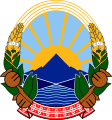Macedonians facts for kids
Macedonians, also known as North Macedonians, are people who live in North Macedonia. Macedonians are an indigenous ethnic group on the territory of Macedonia, which speaks the Macedonian language.
Contents
Origins
The Slavic languages from which Macedonian developed are thought to have grown in the region during the post-Roman period. Many parts of Macedonian culture developed during the rule of Medieval Byzantine, Bulgarian and Serbian Empires. Each of these empires controlled the region for a time.
Macedonians' genetic background is thought to be the same as Balkan prehistoric and historic demographic processes. This background is also found in other South Slavs, especially Bulgarians, Serbs, Bosnians, Montenegrins, but also in northern Greeks and Romanians.
The appearance of Ril Slavs in Macedonia and the Balkans happened after the end of Roman authority. Migrations into the area happened, but on a smaller scale:
"It is now generally agreed that the people who lived in the Balkans after the Slavic "invasions" were probably for the most part the same as those who had lived there earlier, although the creation of new political groups and arrival of small immigrants caused people to look at themselves as distinct from their neighbours, including the Byzantines".
Later, the Sclaveni in Macedonia were added into the Bulgarian Empire.
The history of the ethnic Macedonians has been shaped by population shifts and political developments in the region of Macedonia. After the end of the Ottoman Empire in the early 20th century, the Socialist Republic of Macedonia was created after World War II, a state in the framework of the Socialist Federal Republic of Yugoslavia.
Population
A large majority of ethnic Macedonians live along the valley of the river Vardar, the central region of North Macedonia. They form about 64.18% of the population of North Macedonia (1,297,981 people according to the 2002 census). Smaller numbers live in eastern Albania, northern Greece, and southern Serbia, mostly near the border areas of North Macedonia. A large number of Macedonians have immigrated overseas to Australia, United States, Canada and in many European countries: Germany, the United Kingdom, Italy, and Austria, among others.
Economy
In the past, the Macedonian population was mostly involved with agriculture. The beginning of the People's Republic of Macedonia started a social change. The change was based on Socialist principles, a middle and heavy industry were started.
Language
The Macedonian language (македонски јазик) is a member of the Eastern group of South Slavic languages. Standard Macedonian was started as the official language of the Socialist Republic of Macedonia. After being codified in the 1940s, a strong literary tradition has developed.
The closest relative of Macedonian is Bulgarian, followed by Serbo-Croat. All the South Slavic languages, including Macedonian, form a dialect continuum, in which Macedonian is between Bulgarian and Serbian. The Torlakian dialect group is intermediate between Bulgarian, Macedonian and Serbian.
The orthography of Macedonian includes an alphabet, which is an adaptation of the Cyrillic script. There are also language-specific ways of spelling and punctuation.
Symbols
- Sun: The official flag of North Macedonia, adopted in 1995, is a yellow sun with eight broadening rays extending to the edges of the red field.
- Coat of Arms: After independence in 1992, North Macedonia kept the coat of arms adopted in 1946.
- Vergina Sun: (official flag, 1992–1995) The Vergina Sun is used by several groups in the Macedonian diaspora. The Vergina Sun is believed to have been associated with kings such as Alexander the Great/Alexander Macedon and Philip II, although it was used as an ornamental design long before the Macedonian period. The symbol was discovered in the present-day of Macedonia regard it as a misappropriation of a Macedonian symbol, unrelated to Slavic cultures, and a direct claim on the legacy of Philip II. Greece had the Vergina Sun copyrighted under WIPO as a State Emblem of Greece in the 1990s. The Vergina sun on a red field was the first flag of the independent North Macedonia, until it was removed from the state flag under an agreement reached between North Macedonia and Greece in September 1995. The Vergina sun is still used unofficially as a national symbol by some groups in the country and the Macedonian diaspora.
Related pages
- Brown, Keith, The Past in Question: Modern Macedonia and the Uncertainties of Nation, Princeton University Press, 2003. ISBN: 0-691-09995-2.
- Cowan, Jane K. (ed.), Macedonia: The Politics of Identity and Difference, Pluto Press, 2000. A collection of articles.
- Igor Janev, Legal Aspects of the Use of a Provisional Name for Macedonia in the United Nations System, American Journal of International Law, Vol.93, no. 1, January 1999, http://www.asil.org/ajil/AJILJan1999.pdf




